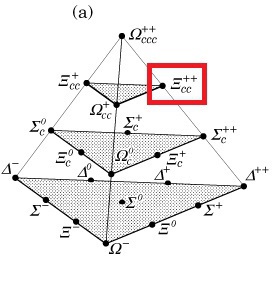Secret Fawful
Member
It's not as unwieldy as they make it out to be. Xi is a letter in the greek alphabet (which are frequently used to name families of particles). The cc is because it has two charm quarks, the ++ denotes its electric charge, in this case twice the charge of a proton.
Edit: To give a bit of context, consider eg the particles below (I've highlighted our culprit in red):

This diagram shows a number of particles that are predicted by the standard model. In this case, they are all baryons, which means that they are made up of 3 quarks (which are smaller, more fundamental particles). Each point represents a type of particle. The particles here are evenly distributed, and each particle represents a distinct quark combination, and thus distinct properties. For instance, electric charge increases from bottom left to top right (denoted by the -, 0, +, or ++ superscripts), whereas the number of charm quarks increases from bottom to top (denoted by the empty, c, cc, or ccc subscripts).
Physicists really like symmetry, because it hints at a well-ordered basic structure of the universe. The neat thing about this is then that it confirms the existence of yet another predicted particle, and thus further serves to cement the standard model.
Thank you for the context. This stuff is very, very interesting to me.

